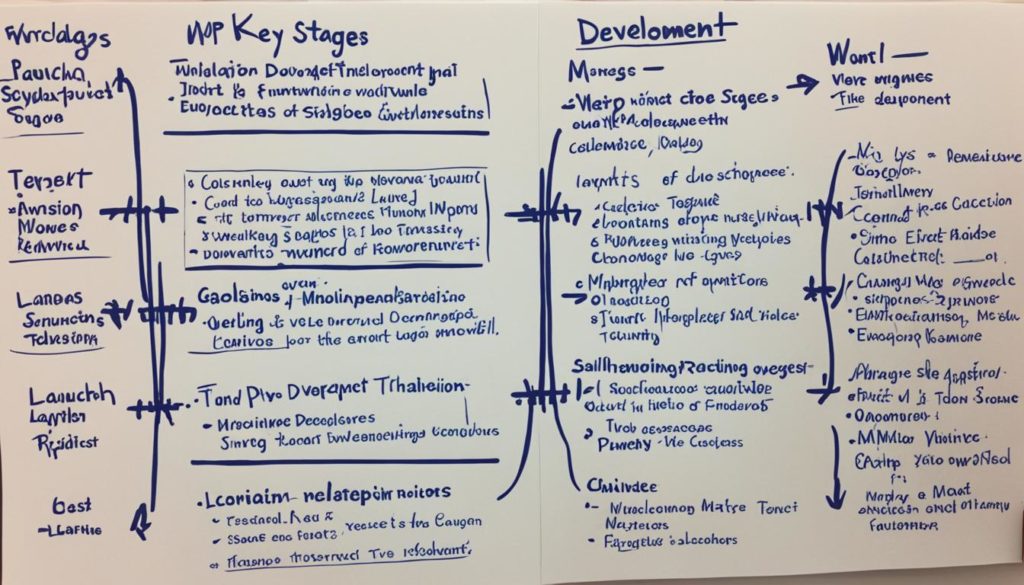
Did you know 88% of online shoppers won’t come back after a bad experience? This shows how vital good User Experience Principles and Interaction Design are today. When we understand and use these rules, we keep customers happy. We give them a smooth, easy journey that meets their needs and goals.
Great user experiences come from knowing what users need, want, and face as challenges. By focusing on these, we can make products that are useful and fun. Sticking to the main UX rules means happier customers who stay loyal. This cuts down on customer service costs and keeps us ahead of the competition.
Key Takeaways
- Following User Experience Principles boosts customer happiness and loyalty.
- Good Interaction Design stops customers from leaving your site unhappy.
- It’s very important to really understand what users need for great UX design.
- Good UX design makes support cheaper and gives you a competitive edge.
- Making things simple and intuitive is key to keeping users around.
Introduction to UX Principles
Understanding UX design is key for making products people love to use. These rules help designers make decisions that improve how users interact with products. They focus on making products easy to use, accessible, and in the user’s control.
Definition of UX Principles
UX design principles are like secret recipes for a great design. They ensure products are easy, efficient, and enjoyable to use by putting the user first. By following these guidelines, products become more satisfying, keep users coming back, and even boost sales. This source highlights how visual hints and giving users control are crucial for success.
Importance of UX Principles
For design teams, using UX principles is vital to create meaningful products. They use research, strategies, prototypes, and testing to meet user expectations. Jakob Nielsen, a big name in UX, says that user control is a top priority in web design. For beginners, the Introduction to User Experience Principles course is a great start, with tons of enrollments and high praise from students.
Benefits of Applying UX Principles
The perks of sticking with UX designs are huge:
- Enhanced User Experience: Better usability and happier users.
- Brand Loyalty: Positive interactions make customers stick around longer.
- Better Conversion Rates: Well-designed paths encourage users to take action.
- Reduced Support Costs: Intuitive designs cut down on help requests.
Keeping up with UX design keeps products fresh and user-friendly. Using insights from courses and resources like the UX Design Institute’s blog can make a team more successful.
| Course | Duration | Modules | Rating | Instructor Rating |
|---|---|---|---|---|
| Introduction to User Experience Principles and Processes | 11 hours | 6 | 4.8/5 | 4.8/5 |
User-Centered Design for Enhanced User Experience
User-Centric Design (UCD) is essential in today’s UX principles. It focuses on putting users at the forefront of the design process. By knowing what challenges and preferences users have, designers can create experiences that are both intuitive and enjoyable.
Understanding User Needs
At the heart of User-Centric Design is grasping user needs. Through comprehensive user research, we identify what users like, struggle with, and aim for. Take the Baymard Institute: they’ve put over 130,000 hours into UX research. This deep dive into user needs leads to smarter design choices. For instance, solving issues like too many product categories or not saving user searches can make shopping online a lot better.
Methods for User Research
Various User Research Methods are used to collect important insights. Techniques span from in-app surveys to user testing and analyzing behavior. Research on 10 e-commerce sites showed major usability problems. It proves how vital these methods are. Tools like UXCam provide powerful analytics. They have a free plan that covers 10,000 sessions a month and a trial with 100,000 sessions. This lets designers test and improve their choices continuously.
Applying User Insights to Design
Using user feedback well is key in iterative design. This approach includes regular usability testing and using analytics. User-Centric Design principles stress teamwork. It creates a space where everyone can share ideas and insights. Putting user needs first reduces the effort to learn how to use products. It makes products more usable. This leads not only to happier users but also to more loyalty, better sales figures, and lower development costs since issues are caught and fixed early.
Design Consistency and Predictability
Keeping the design consistent and making the UI predictable is key for a great user experience. When users see interfaces they know, they can quickly learn how to use them. This adds to their trust and happiness.
Importance of Consistency in UI
UI consistency lets users recognize and get the function of different parts easily. This lowers stress and makes using it smoother and more fun. Consistent design across screens ensures a smooth experience everywhere.
Building Trust Through Predictability
Predictable UIs build trust by being reliable. Knowing what will happen next makes users feel more confident. This reduces mistakes and keeps users engaged by improving the learning process.
Examples of Consistent Design Patterns
Companies like Google and Apple show the value of consistent design for happy users. For example, using the same styles for buttons and forms helps users recognize them fast. Here’s how some common designs compare:
| Design Pattern | Apple | |
|---|---|---|
| Button Design | Flat, material design | Rounded, shadowed |
| Navigation Bar | Sticky at the top | Floating at the bottom |
| Form Fields | Outlined with labels | Underlined with placeholders |
In conclusion, using consistent design patterns and making the UI predictable improves usability. It also helps in earning the users’ trust and loyalty.
Simplicity and Intuitive Design
Keeping UX design simple and intuitive is key for friendly interfaces that improve user experience. By focusing on clarity and simplicity, users find it easy to use products.
Reducing Cognitive Load
It’s vital to reduce cognitive load to make the user journey simple. Clear interfaces help users understand info quickly, making them happier. Using clear language and simplifying tasks help users make decisions easily.
This tactic aids in user understanding and improves the user experience optimization by focusing on what’s important.
Implementing Simple Navigation
To enhance navigation, we apply minimalist design. Making the interface intuitive helps users find their needs with ease. Consistency in design elements like typography and colors makes navigation predictable and user-friendly.
Avoiding Unnecessary Complexity
Limiting complexity means balancing simplicity with function. It requires focusing on the user’s needs and avoiding confusing elements. An approach that foresights users’ future needs without complicating the interface is best.
Utilizing minimalist design principles reduces cognitive load, improving usability and efficiency. This leads to better user comprehension and satisfaction, highlighting simplicity’s role in UI/UX design.
Applying intuitive design boosts user experience significantly. As UX design experts advise, merging this with usability testing and updates leads to efficient, user-focused products.
Enhancing Usability for Better User Engagement
Making your product easy and enjoyable to use is key. By focusing on Usability Guidelines and improving Interaction Design, we can make things more engaging for users. They’ll find our products intuitive and fun.
Core Elements of Usability
Usability is all about satisfaction, efficiency, and effectiveness. It ensures our product is simple to learn and use. By sticking to Usability Guidelines, we improve these aspects. This makes users more engaged and their interactions more enjoyable.
Techniques for Improving Learnability
Making it easy for new users to learn our product is critical. We can make the learning curve smoother with intuitive interfaces and clear directions. Things like guided tours and interactive help can make learning easier. These are some of the best Interaction Design tricks.
Efficiency and Error Prevention
We can make things faster by designing simple workflows. Steering clear of repetitive tasks is key. Following Usability guidelines, we pinpoint and fix slowdowns. Preventing errors is also essential. By setting up checks and rules, we help users avoid mistakes. This keeps their experience smooth and frustration-free.
| Usability Element | Description | Best Practices |
|---|---|---|
| Learnability | Ease of learning the system | Guided tours, clear instructions |
| Efficiency | Speed of task completion | Simplified workflows, minimizing repetitive tasks |
| Error Prevention | Reducing user mistakes | Implementing constraints, validation rules |
Creating Accessible Designs
Making sure our digital products are easy for everyone to use is very important. By focusing on accessibility in UX Design, we reach more people. This not only grows our user base but makes the experience better for everyone.
Importance of Accessibility
Accessibility is not just about following laws. It’s about creating an experience everyone can enjoy. By thinking about everyone, we invite millions of users who might otherwise miss out.
Designing for Users with Disabilities
To design for users with disabilities, we use bright visuals and clear text. We also make sure our designs work well with tools that help these users interact. Following guidelines like the W3C’s Web Accessibility Initiative is key.
Tools and Techniques for Accessibility
There are many ways to make designs more accessible. Using screen readers and making sites easy to navigate without a mouse helps users with vision issues. Also, choosing colors that stand out and text that can get bigger is important.
| Accessibility Tool | Function |
|---|---|
| Screen Readers | Convert digital text into audio for visually impaired users |
| Alt Text | Provides image descriptions for better context |
| High-Contrast Mode | Enhances readability for users with visual impairments |
| Keyboard Navigation | Allows users to navigate through the interface using a keyboard |
Adding these features helps us meet legal requirements and make everyone’s experience better. It’s about including all users in the digital world.
Responsive and Mobile-Friendly Design
Today, having a responsive design is key. With most internet use on mobile, sites must work well on those devices. This improves how users feel and increases conversions. A great responsive design works well on any device, keeping both its function and look.
We aim to create a Mobile UX that users love. People want fast interactions and easy-to-use sites. We avoid things like slow websites and hard-to-use menus. Let’s think about how to make designs responsive and friendly to mobile users:
- Fluid Grids: Use relative units like percentages to allow layouts to adapt to different screen sizes.
- Flexible Images: Ensure images resize within their containing elements without losing quality.
- Viewport Meta Tags: Optimize the viewport for different configurations to improve the Mobile UX.
Responsive design is more than just looks. It’s about the whole experience. Adding touch-friendly elements and easy navigation makes Mobile UX better. Paying attention here means users enjoy using the site more. That leads to them staying longer and happier customers.
By focusing on responsive design, we make our content good for any device. This approach keeps our current users happy and draws in new ones. A smooth mobile experience is now a must for businesses to succeed.
Conclusion
Using UX principles in product design is a must for success. It helps in today’s digital world. With design thinking and information architecture, we make user experiences that work well and are easy to use.
By following the 17 UX design rules, we can make customers happier and more loyal. We improve user experience by making things easy to use and personalized. This includes making things accessible and providing many ways for customer support.
Keeping things simple and listening to what users say is important. It makes things easier to use and reduces confusion. Statistically, bad user experiences make 70% of customers stop their purchases. Also, 80% won’t come back if the site doesn’t work on their phones. It’s key to make the UX design connect with the real world. As we grow, sticking to these principles is crucial for better user connections and experiences.
FAQ
What are UX Principles?
UX Principles guide designers to make easy-to-use products. They ensure we focus on what users need the most. This helps in making better design decisions.
Why are UX Principles important?
UX Principles make products better for users. They help improve user work, make them happier, and build loyalty. They also make products easier to support and sell.
What benefits do UX Principles offer?
Using UX Principles boosts user happiness and keeps them coming back. It also cuts down on support costs. Plus, it helps your product stand out in the market.
How do we understand user needs for UX design?
To understand user needs, we start by looking at their challenges. We use surveys, tests, and analyze how they use apps. These methods give insights for designing better solutions.
What methods can we use for user research?
For user research, we use surveys, interviews, tests, and study behaviors. These tools help us get the information we need to design with the user in mind.
How do we apply user insights to design?
We use feedback, make our designs personal, and let users customize. This way, we make sure our designs match what users want. This improves the user experience.
Why is consistency in UI important?
Consistency makes the UI predictable, which helps users trust the product. They learn how to use it faster, enjoying a smooth experience.
How does consistency build trust?
When the design is consistent, users know what to expect. This reduces their frustration and makes them more likely to keep using the product.
Can you provide examples of consistent design patterns?
Sure, consistent design examples include the same colors, buttons, and fonts across the app. This helps users interact with the product more easily.
How do we reduce cognitive load in design?
To reduce cognitive load, we make clear, simple interfaces. We break big tasks into smaller ones and use straightforward language. Giving fewer choices also helps.
What are some ways to implement simple navigation?
For simple navigation, organize content well and use clear labels. Minimize the number of clicks to get to important information. Also, offer shortcuts for common tasks.
Why should we avoid unnecessary complexity in design?
Too much complexity can make users feel lost and give up. Simple designs help keep their attention and lower their stress, increasing satisfaction.
What are the core elements of usability?
Usability is about making products satisfying, error-free, easy to learn, quick to use, and simple to come back to. This makes for a great user experience.
What techniques can we use to improve learnability?
To improve learnability, provide clear instructions, use familiar designs, add interactive guides, and ensure the product is simple to use.
How do we ensure efficiency and error prevention in design?
We make navigation user-friendly, prevent errors before they happen, and design efficient ways for users to accomplish tasks. This creates a smooth experience.
Why is accessibility important in design?
Accessibility matters because it makes sure everyone can use the product, including people with disabilities. This makes the product usable by a wider audience.
How can we design for users with disabilities?
Designing for accessibility means high-contrast visuals, text for images, and supporting tech aids. Following W3C’s Web Accessibility Initiative standards is key.
What tools and techniques can we use for accessibility?
For accessibility, we use tools like screen readers and keyboard navigation. We also resize text and do audits to meet standards.
Why is responsive and mobile-friendly design imperative?
Responsive design is a must because most people use mobile devices now. It ensures a good experience on any device, which can increase users and sales.
Future App Studios is an award-winning software development & outsourcing company. Our team of experts is ready to craft the solution your company needs.










